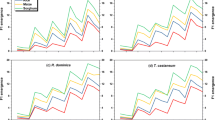Abstract
Persistence and efficacy of four Iranian diatomaceous earth formulations was assessed against Sitophilus oryzae (L.), Tribolium castaneum (Herbst) and Tribolium confusum Jacquelin du Val. on barley, rice and wheat. Three diatomaceous earth samples were collected from Maragheh, Mamaghan, and Khorasan Jonoobi mines and Sayan® formulation was obtained from Kimia Sabz Avar Company. Mortality of the exposed individuals was recorded after 2, 5, 10 and 14 days of exposure. The mortality of all tested species was higher on wheat followed by barley. The insect mortality increased with increasing concentration level. In most cases, Khorasan was the most effective diatomaceous earth deposit. LC50 values of Khorasan deposit was 155.3, 201.5 and 293.7 ppm for S. oryzae, T. castaneum and T. confusum, respectively when exposed for 7 days on treated wheat. Adults of S. oryzae were the most susceptible species to diatomaceous earths. Subsequently, the persistence of diatomaceous earths was assessed after 1, 2, 3, 4, 6 and 8 months of storage. Mortality of all the tested species was high in first four months of storage but decreased rapidly overtime.






Similar content being viewed by others
References
Hill DS (2002) Pests: Class Insecta. Pests of stored foodstuffs and their control. Kluwer Academic Publishers, Springer, Malaysia, pp 135–316
Korunic Z (2013) Diatomaceous earths: natural insecticides. Pestic Fitomed 28(2):77–95
Korunic Z, Rozman V, Hamel D, Liska A (2011) Long term effectiveness of several grain protectants on wheat. In: Athanassiou CG, Kavallieratos NG, Weintraub PG (eds) Working group “integrated protection of stored products” IOBC-WPRS Bulletin. Proceedings of the meeting at Volos, pp 7–16
Fields PG (1998) Diatomaceous earth: advantages and limitations. In: Jin Z, Liang Q, Liang Y, Tan X, Guan L (eds) 7th international working conference on stored-product protection. Sichuan Publishing House of Science and Technology, Beijing, China, pp 781–784
Shah MA, Khan AA (2014) Use of diatomaceous earth for the management of stored-product pests. Int J Pest Manag 60(2):100–112
Stathers TE, Denniff M, Golob P (2004) The efficacy and persistence of diatomaceous earths admixed with commodity against four tropical stored product beetle pests. J Stored Prod Res 40(1):113–123
Athanassiou CG, Kavallieratos NG, Economou LP, Dimizas CB, Vayias BJ, Tomanović S, Milutinović M (2005) Persistence and efficacy of three diatomaceous earth formulations against Sitophilus oryzae (Coleoptera: Curculionidae) on wheat and barley. J Econ Entomol 98(4):1404–1412
Vayias BJ, Athanassiou CG, Kavallieratos NG, Tsesmeli CD, Th Buchelos C (2006) Persistence and efficacy of two diatomaceous earth formulations and a mixture of diatomaceous earth with natural pyrethrum against Tribolium confusum Jacquelin du Val (Coleoptera: Tenebrionidae) on wheat and maize. Pest Manag Sci 62(5):456–464
Korunic Z, Ormesher P (1998) Evaluation and standardised testing of diatomaceous earth. In: Zuxun J, Quan L, Yongsheng L, Xianchang T, Lianghua G (eds) 7th international working conference on stored-product protection. Sichuan Publishing House of Science and Technology, pp 738–744
Ziaee M, Moharramipour S (2012) Efficacy of Iranian diatomaceous earth deposits against Tribolium confusum Jacquelin du Val (Coleoptera: Tenebrionidae). J Asia Pac Entomol 15(4):547–553
Ziaee M, Atapour M, Marouf A (2016) Insecticide effectiveness of Iranian diatomaceous earths on adults of Oryzaephilus surinamensis. J Agric Sci Technol 18(2):361–370
Robertson JL, Smith KC, Savin NE, Lavigne RJ (1984) Effects of dose selection and sample size on the precision of lethal dose estimates in dose mortality regression. J Econ Entomol 77(4):833–837
Finney DJ (1971) Probit analysis. Cambridge University Press, London
SPSS (2007) SPSS 16 for windows user’s guide release. Spss Inc, Chicago
Ziaee M (2015) Influence of grain type on the susceptibility of Tribolium confusum adults to three diatomaceous earth formulations. J Crop Protect 4(1):113–119
Aldryhim YN (1993) Combination of classes of wheat and environmental factors affecting the efficacy of amorphous silica dust, Dryacide, against Rhyzopertha dominica (F.). J Stored Prod Res 29(3):271–275
Athanassiou CG, Kavallieratos NG, Andris NS (2004) Insecticidal effect of three diatomaceous earth formulations against adults of Sitophilus oryzae (Coleoptera: Curculionidae) and Tribolium confusum (Coleoptera: Tenebrionidae) on oat, rye, and triticale. J Econ Entomol 97(6):2160–2167
Ziaee M, Nikpay A, Khashaveh A (2007) Effect of oilseed type on the efficacy of five diatomaceous earth formulations against Tribolium castaneum Herbst (Coleoptera: Tenebrionidae). J Pest Sci 80(4):199–204
Korunic Z (1998) Diatomaceous earths, a group of natural insecticides. J Stored Prod Res 34(2–3):87–97
Arthur FH (2000) Toxicity of diatomaceous earth to red flour beetles and confused flour beetles (Coleoptera: Tenebrionidae): effects of temperature and relative humidity. J Econ Entomol 93(2):526–532
Snetsinger R (1988) Report on Shellshock insecticide. Report of Department of Entomology, Pennsylvania State University, pp 1–7
Saez A, Fuentes Mora VH (2007) Comparison of the desiccation effects of marine and freshwater diatomaceous earths on insects. J Stored Prod Res 43(4):404–409
Acknowledgments
The authors appreciate Shahid Chamran University of Ahvaz for the support. This study was supported by Iran National Science Foundation (INSF) with Grant Number of 92023007.
Author information
Authors and Affiliations
Corresponding author
Ethics declarations
Conflict of interest
None.
Electronic supplementary material
Below is the link to the electronic supplementary material.
Rights and permissions
About this article
Cite this article
Ziaee, M., Atapour, M. & Marouf, A. Persistence and Efficacy of Four Iranian Diatomaceous Earths Against Three Stored Grains Beetles. Proc. Natl. Acad. Sci., India, Sect. B Biol. Sci. 88, 411–419 (2018). https://doi.org/10.1007/s40011-016-0774-3
Received:
Accepted:
Published:
Issue Date:
DOI: https://doi.org/10.1007/s40011-016-0774-3




